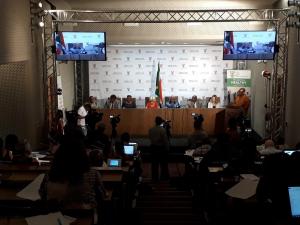Listeriosis outbreak in South Africa
Yesterday, South Africa’s Minister of Health, Dr Aaron Motsoaledi, announced that the country has 727 laboratory-confirmed cases that occurred between January 2017 and 5 January 2018. He made this announcement at a national media conference accompanied by Prof Lucille Blumberg, Specialist Microbiologist, and Dr Juno Thomas, Head of the Centre for Enteric Diseases, both of the National Institute for Communicable Diseases (NICD); Dr Rufaro Chatora, Country Representative from the World Health Organization; Mr Mooketsa Ramasodi, Acting Director General for the Department of Agriculture, Forestry and Fisheries (DAFF); and Ms Tiny Rennie, Acting Director-General of the Department of Health.
The Minister told the Media that the National Multi-sectoral Outbreak Response Team (MNORT) led by the National Department of Health, and includes the Department of Agriculture, Forestry and Fishery (DAFF), the Department of Trade and Industry, the NICD and other relevant stakeholders continues to monitor and coordinate the outbreak response activities.
He called on all South Africans to practice basic food hygiene principles as outlined in the World Health Organization’s ‘Five Keys to Safer Food’ programme.
The core ‘commandments’ of food hygiene are:
- Keep clean: wash your hands before handling food and often during food preparation
- Separate raw and cooked: separate raw meat, poultry and seafood from other foods
- Cook thoroughly: cook foods thoroughly, especially meat, poultry, eggs and seafood
- Keep food at safe temperatures: refrigerate and reheat foods correctly
- Use safe water and raw materials: use safe water or make it safe (by boiling); choose foods processed for safety such as pasteurized dairy products; wash fruits and vegetables thoroughly, especially if eaten raw.
In his brief remarks, Dr Chatora commended South Africa’s response and openness about the outbreak. “The Government of South Africa shared the detailed information with WHO in compliance with the provisions of the International Health Regulations. This has helped South Africa and the Global Community at large to protect health, to stand ready to identify, to respond and to control outbreaks where they occur in keeping with the regulations.
It is also great to see how in South Africa different sectors such as Agriculture, Food Industry and Farming have come together with the Health sector to fight Listeriosis and to interrupt the outbreak.
The country has also implemented some important measures such as making Listeriosis a notifiable condition for the first time ever. This is helping to track the diseases”.
Since 5 December 2017, the Department of Health amended the list of notifiable diseases to include Listeriosis. Prior to this outbreak, Listeriosis was not a notifiable condition.
Dr Rufaro also assured the Minister of Health that WHO and the International Community stand ready to support the Department of health and other departments involved in fighting this outbreak.
Listeriosis Outbreak in South Africa
Listeriosis is now a notifiable condition in South Africa. Since 5 December 2017, the Department of Health amended the list of notifiable diseases to include Listeriosis. Prior to this outbreak, Listeriosis was not a notifiable condition.
For a disease to be notifiable, it has to meet at least two (2) of five (5) qualifying criteria:
- The disease must be contagious/communicable;
- Rapid spread;
- Unusual or unexpected behaviour;
- Risk of spilling across borders;
- Risk of restriction to business or travel across borders
The current outbreak qualifies in at least 2 of the criteria, i.e. Rapid spread and unusual or unexpected behaviour.
It is for this reason that the Department of Health introduced a new policy of making Listeriosis notifiable and this is appearing in Government Gazette No. 41330 of 15 December 2017.
Preventable and treatable
Listeriosis is a serious, but preventable and treatable disease caused by the bacterium, Listeria monocytogenes. The bacteria are widely distributed in nature and can be found in soil, water, vegetation and the faeces of some animals. Animal products (including meat, meat products, dairy products), seafood and fresh produce such as fruits and vegetables can be contaminated from these sources
Distribution of cases in the country as at 05 January 2018
- Gauteng still no. 1 at 61% (442/727) - in December it was 62% (345/557;
- Western Cape is still no. 2 at 13% (92/727) - in December it was 13% (71/557);
- KwaZulu Natal is still no. 3 at 7% (51/727) - in December it was 7% (37/557);
65% (473/723) are occurring in the public sector - in December it was 66% and 35% (251/724) are occurring in the private sector - in December it was 34%.
Appeal to all health workers
Report all cases of Listeriosis in terms of reporting procedures applicable to all notifiable diseases



